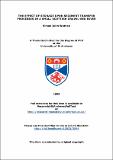Files in this item
The effect of storage upon sediment transfer processes in a small Scottish gravel-bed river
Item metadata
| dc.contributor.advisor | Werritty, Alan | |
| dc.contributor.advisor | Hoey, T B | |
| dc.contributor.author | Wathen, Simon John | |
| dc.coverage.spatial | 373 | en_US |
| dc.date.accessioned | 2013-07-12T14:11:08Z | |
| dc.date.available | 2013-07-12T14:11:08Z | |
| dc.date.issued | 1995 | |
| dc.identifier | uk.bl.ethos.571483 | |
| dc.identifier.uri | https://hdl.handle.net/10023/3844 | |
| dc.description.abstract | A detailed morphological approach is used to determine the effect of storage location upon sediment mobility, providing partial explanation for previously reported non systematic characteristics of sediment transfer. Data were collected over a period of 2 years from a small river in the Highlands of Scotland. Sediment transfer fluxes and volumetric storage were measured using an integrated data collection programme utilising 990 magnetic tracers and 225 cross sections spaced at c1 m intervals over two contrasting reaches (A and B). Scaled tracer fluxes were monitored between 6 numerically defined storage types (very active, active, semi active, stable, inactive and dormant). Storage characteristics were determined using response time, defined as the time at which cumulative output from a store exceeds sediment in storage. Activity progressively declined from very active to inactive stores, the exact magnitude being a function of local morphology, particularly the presence of fixed bars. Inter store exchanges of sediment were assessed using descriptive matrices categorised into individual types according to transfer and storage proportions. A relative dimensionless shear stress scale used to differentiate the storage conditions responsible for the occurrence of each matrix type indicated that transfer in reach A is a function of hydraulic conditions, grain size and storage, in reach B grain size is the only dominant factor. These controlling factors were subdivided into peak stage, duration, relative and absolute grain size, morphology and burial and assessed with reference to fractional transfer distances. The relative importance of each factor to transfer depends upon storage location and the incidence of morphological change. Comparison between tracer and volumetric fluxes provides explanation for sediment transfer distributions and allows assessment of morphological controls upon channel pattern maintenance. The results from this study were summarised in two conceptual models describing downstream and within reach sediment transfer. | en_US |
| dc.language.iso | en | en_US |
| dc.publisher | University of St Andrews | |
| dc.title | The effect of storage upon sediment transfer processes in a small Scottish gravel-bed river | en_US |
| dc.type | Thesis | en_US |
| dc.type.qualificationlevel | Doctoral | en_US |
| dc.type.qualificationname | PhD Doctor of Philosophy | en_US |
| dc.publisher.institution | The University of St Andrews | en_US |
This item appears in the following Collection(s)
Items in the St Andrews Research Repository are protected by copyright, with all rights reserved, unless otherwise indicated.

